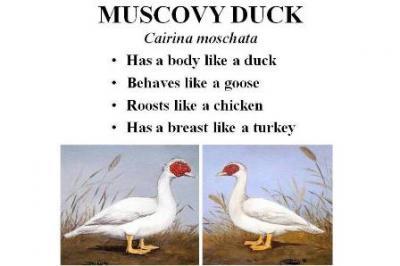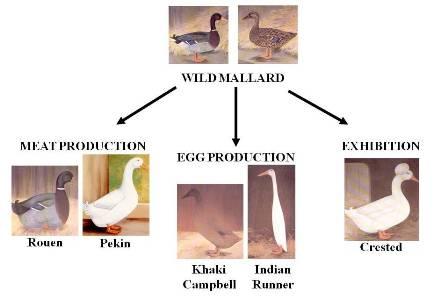Duck

All the different breeds of ducks (except for Muscovy's) are descendant from the wild mallard. This is based on the presence of the sex-feather in the tail of the male mallard as well as the males of the domesticated duck breeds. The mallard is the only wild duck that has this type of tail feather.
 Although we call the muscovy a duck it is technically not a duck. The muscovy is a South American waterfowl that has a body like a duck, behavaes like a goose in that it hisses rather than quacks, has a breast like a turkey, and roosters like a chicken. The incubation period for a muscovy is 35 days, instead of the typical 28 days for ducks. Although muscovies will breed with domestic ducks, the resulting offspring are infertile and are called 'mule' ducks. The term 'moulard' duck is sometimes used for the offspring of a muscovy male and a pekin female. Again the offspring are infertile. The term 'magret' refers to the breast from the moulard duck and it is sometimes aged out to 7 days to augment flavor.
Although we call the muscovy a duck it is technically not a duck. The muscovy is a South American waterfowl that has a body like a duck, behavaes like a goose in that it hisses rather than quacks, has a breast like a turkey, and roosters like a chicken. The incubation period for a muscovy is 35 days, instead of the typical 28 days for ducks. Although muscovies will breed with domestic ducks, the resulting offspring are infertile and are called 'mule' ducks. The term 'moulard' duck is sometimes used for the offspring of a muscovy male and a pekin female. Again the offspring are infertile. The term 'magret' refers to the breast from the moulard duck and it is sometimes aged out to 7 days to augment flavor.

As with chickens, there are meat, egg and exhibition breeds of ducks. Some of the egg-laying breeds can lay more eggs per year than many chicken breeds. Some of hte meat breeds of ducks are also used to produce foie gras, which is a delicacy made from the fatty liver of ducks or geese.
Vocabulary
- Duck is singluar, Ducks in plural
- Duck/Hen = adult female duck
- Drake = adult male duck
- Duckling = young (baby) duck
- Foie gras = French for 'fat liver' and is a food product made form the liver of a duck or goose that has been specifically fattened.
